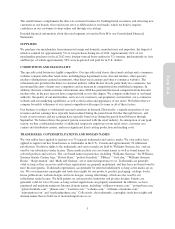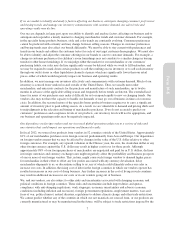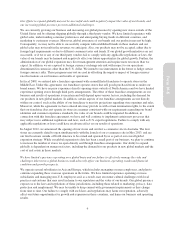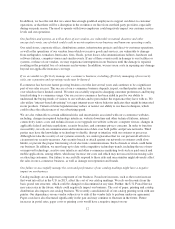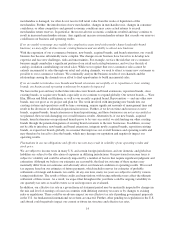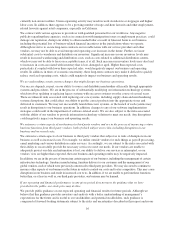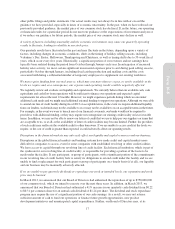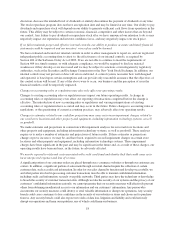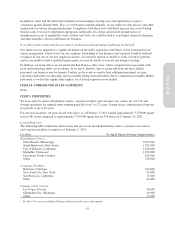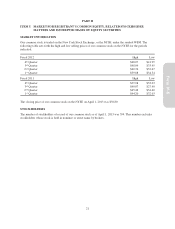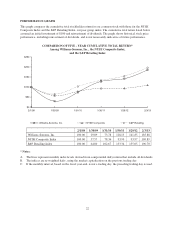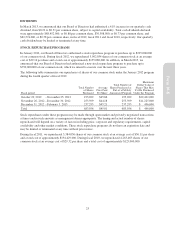Pottery Barn 2012 Annual Report Download - page 28
Download and view the complete annual report
Please find page 28 of the 2012 Pottery Barn annual report below. You can navigate through the pages in the report by either clicking on the pages listed below, or by using the keyword search tool below to find specific information within the annual report.merchandise is damaged, we often do not receive full retail value from the resale or liquidation of the
merchandise. Further, the introduction of new merchandise, changes in merchandise mix, changes in consumer
confidence, or other competitive and general economic conditions may cause actual returns to exceed
merchandise return reserves. In particular, the recent adverse economic conditions resulted and may continue to
result in increased merchandise returns. Any significant increase in merchandise returns that exceeds our reserves
could harm our business and operating results.
If we are unable to manage successfully the complexities associated with a multi-channel and multi-brand
business, we may suffer declines in our existing business and our ability to attract new business.
With the expansion of our e-commerce business, new brands, acquired brands, and brand extensions, our overall
business has become substantially more complex. The changes in our business have forced us to develop new
expertise and face new challenges, risks and uncertainties. For example, we face the risk that our e-commerce
business might cannibalize a significant portion of our retail and catalog businesses, and we face the risk of
catalog circulation cannibalizing our retail sales. While we recognize that our e-commerce sales cannot be
entirely incremental to sales through our retail and catalog channels, we seek to attract as many new customers as
possible to our e-commerce websites. We continually analyze the business results of our channels and the
relationships among the channels in an effort to find opportunities to build incremental sales.
If we are unable to introduce new brands and brand extensions successfully, or to reposition or close existing
brands, our business and operating results may be negatively impacted.
We have in the past and may in the future introduce new brands and brand extensions, reposition brands, close
existing brands, or acquire new brands, especially as we continue to expand globally. Our newest brands — West
Elm, PBteen and Mark and Graham, as well as our recently acquired brand, Rejuvenation — and any other new
brands, may not grow as we project and plan for. The work involved with integrating new brands into our
existing systems and operations could be time consuming, require significant amounts of management time and
result in the diversion of substantial operational resources. Further, if we devote time and resources to new
brands, acquired brands, brand extensions or brand repositioning, and those businesses are not as successful as
we planned, then we risk damaging our overall business results. Alternatively, if our new brands, acquired
brands, brand extensions or repositioned brands prove to be very successful, we risk hurting our other existing
brands through the potential migration of existing brand customers to the new businesses. In addition, we may
not be able to introduce new brands and brand extensions, integrate newly acquired brands, reposition existing
brands, or expand our brands globally, in a manner that improves our overall business and operating results and
may therefore be forced to close the brands, which may damage our reputation and negatively impact our
operating results.
Fluctuations in our tax obligations and effective tax rate may result in volatility of our operating results and
stock price.
We are subject to income taxes in many U.S. and certain foreign jurisdictions, and our domestic and global tax
liabilities are subject to the allocation of expenses in differing jurisdictions. Our provision for income taxes is
subject to volatility and could be adversely impacted by a number of factors that require significant judgment and
estimation. Although we believe our estimates are reasonable, the final tax outcome of these matters may
materially differ from our estimates and adversely affect our financial condition or operating results. We record
tax expense based on our estimates of future payments, which include reserves for estimates of probable
settlements of foreign and domestic tax audits. At any one time, many tax years are subject to audit by various
taxing jurisdictions. The results of these audits and negotiations with taxing authorities may affect the ultimate
settlement of these issues. As a result, we expect that throughout the year there could be ongoing variability in
our quarterly tax rates as taxable events occur and exposures are evaluated.
In addition, our effective tax rate in a given financial statement period may be materially impacted by changes in
the mix and level of earnings or losses in countries with differing statutory tax rates or by changes to existing
rules or regulations. There could be an adverse impact on our effective tax rate if pending government proposals
in the U.S. for fundamental international tax reform are enacted. Further, other pending tax legislation in the U.S.
and abroad could negatively impact our current or future tax structure and effective tax rates.
14



